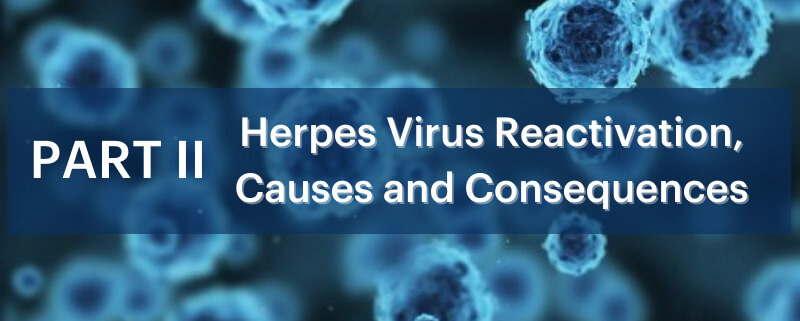INTRODUCTION: In this 2nd Part, we will present reports dealing with the reaction of another group of Herpes viruses, human herpes virus 6 & 7 (HHV 6-7). Over the last 18 months the SARS-CoV-2 virus has led to an increase in Herpes virus reactivations. This virus (SARS-CoV-2) has a series of evasion mechanisms that allow it to circumvent our immune system, thereby leaving the host vulnerable and thus facilitating replication of the virus and the increase in viral load. Two of these evasion mechanisms include 1) the alteration of the synthesis and functionality of interferons type I (INF-alpha & beta) and type 2 (INF-gamma). This allows SARS-CoV-2 to replicate in host cells without opposition or without an effective antiviral state. And 2) a cytokine storm or excessive activation of M1 macrophages with an inordinate amount of pro-inflammatory cytokines released into the serum1. It is the down-regulation INF-gamma which is thought to lead to the reactivation of many Herpes viruses.
DISCUSSION: Pityriasis rosea (PR) is caused by the reactivation of HHV-6-7 and we have seen a rapid rise in cases during the SARS-CoV-2 pandemic. Dursun and Temiz2 found a 5-fold increase in the rate of Pityriasis rosea patients who applied to a dermatology outpatient clinic during the last year (April 1 & May 1 2019 through April 1 & May 1 2020). Collecting data from 2 different months, 1 year apart was to reduce any seasonal development of the disease. There are many other reports of PR in the literature. Birlutiu et al3, reported that the PR cases associated with SARS-CoV-2 infection are in young patients (12-39 years old), with a mean age of 24.12 years, with equal distribution by gender (50/50). The time periods between the onset of the rash and the presentation of the patient to the doctor varied between 3 days and 2 weeks. Healing of the skin lesions required 2-4 weeks ((using antihistamines, antipyretics and topical corticosteroids). Their report adds to other findings regarding the association of PR with SARS-CoV-2 infection, in context of the pandemic, suggesting the need to test patients with PR skin lesions for SARS-CoV-2 infection. Another type of Herpes virus related disease is Kawasaki disease which is a systemic vasculitis of childhood that can affect the coronary arteries. The exact etiology of Kawasaki disease is still unknown; however, many believe HHV-6 is a primary cause. In a study conducted during the COVID-19 pandemic, Kawasaki disease was found to increase 30-fold compared to previous years4. The study by Dursun & Temiz found a 10-fold increase in patients with Kawasaki disease who applied to the dermatology outpatient clinic, compared to the previous year. They believe this increase of Kawasaki disease during the pandemic may be due to the Coronavirus triggering (i.e., reactivation) of HHV-6.
CONCLUSION: In Part I we showed the reports of a large increase of Bell’s Palsy associated with the SARS-CoV-2 infections which is thought to be due to the reactivation of either HSV1/2 or Varicella zoster virus. In Part II we showed the reactivation of other Herpes viruses, HHV-6-7, during the SARS-CoV-2 pandemic. Data is accumulating that the suppression of the immune response during the Coronavirus infection is resulting in the reactivation of a wide range of Herpes viruses.
REFERENCES:
- Maldonado, M.D., J. Rmoero-Aibar, and M.A. Perez-San-Gregorio. (2021) COVID-19 pandemic as a risk factor for the reaction of herpes viruses. Epidemiology and Infection 149, e145,1-5. Https://doi.org/10.1017/S09502688s1001333
- Dursun, R., and A. Temiz. (2020). The clinics of HHV-6 infection in COVID-19 pandemic: Pityriasis rosea and Kawasaki disease. Dermatol Ther 33(4), e13730. Https://doi.org/10.1111/dth.13730.
- Birlutiu, V., R.M. Birlutiu, and G.M. Lancu. (2021) Pityriasis rosea Gibert triggered by SARS-CoV-2 infection. Medicine 100, 14, 1-5. http://dx.doi.org/10.1097/MD.0000000000025352.
- Verdoni, L., A. Mazza, A. Gervasoni, L. Martelli, M. Ruggeri, M. Cuiffreda, E. Bonanomi, and L. D’Antiga. (2020) An outbreak of severe Kawasaki-like disease at the Italian epicentre of the SARS-CoV-2 epidemic: an observational cohort study. Lancet 395, 1771-78. https://doi.org/10.1016/S0140-6736(20)31103-X
By David Kilpatrick, PhD and Abbas Vafai, PhD
MKTG 1062 – Rev A 091021



